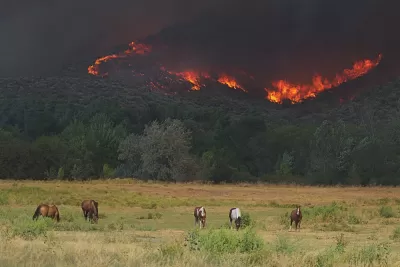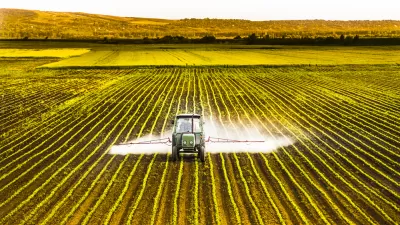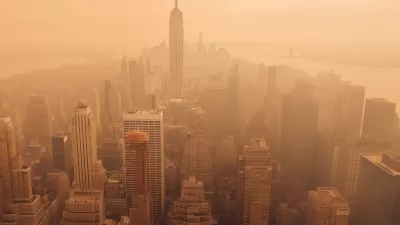While forests sequester atmospheric carbon dioxide, wildfires release enormous amounts of greenhouse gases as they increase in frequency and intensity from climate change.

It takes only one intense California wildfire to wipe out an entire year's reduction of greenhouse gas emissions overseen by the California Air Resources Board (CARB). The huge gap is illustrated in this San Francisco Chronicle graph (jpg) contrasting annual emissions reductions from 2013 through 2015 with emission contributions from wildfires (and those fires are just the ones on federal lands).
However, the U.S. Environmental Protection Agency and CARB only measure emissions from anthropogenic (attributed to a "direct result of human activities or are the result of natural processes that have been affected by human activities" per CARB glossary) sources for inventory purposes.
"The board has spent much of the last decade researching how to calculate and track wildfire emissions and is working on a year-by-year tally," reports David R. Baker on November 21 for the San Francisco Chronicle.
There’s a lot of uncertainties in quantifying this,” said Dave Edwards, chief of the board’s greenhouse gas inventory branch. “It’s not like power plants burning fossil fuels.”
“We can go from carbon sink to source in a five- to 10-year period,” adds Dick Cameron, director of science for California land programs at the Nature Conservancy environmental organization.
One study commissioned by the Air Resources Board estimated that from 2001 through 2010, the amount of carbon stored in California’s natural and working lands decreased by 150 million metric tons, with 80 percent of those losses coming from wildfires.
To reduce emissions from wildfires, measures being considered include "careful management of California’s forests by removing dead or smaller trees that have been allowed to proliferate through decades of fire-suppression policies," writes Baker.
That can be done through targeted logging or by small, intentionally set fires during times when weather conditions aren’t likely to spread them out of control — as is already done in many forests around the state.
“We just have way too much fuel in our forested landscapes,” said Jim Branham, executive officer of the Sierra Nevada Conservancy, a state agency charged with protecting the ecological and economic health of the Sierra region.
Black carbon
Not mentioned by Baker is the "super-greenhouse gas pollutant" black carbon, 3,200 times more powerful than CO2. Among the largest sources are wildfires and anthropogenic wood-burning. California just passed a voluntary wood smoke reduction program, focused on replacing older wood-burning stoves with more efficient ones or alternatives, in order to reduce black carbon emission.
Hat tip to Janet Strömberg.
FULL STORY: Huge wildfires can wipe out California’s greenhouse gas gains

Study: Maui’s Plan to Convert Vacation Rentals to Long-Term Housing Could Cause Nearly $1 Billion Economic Loss
The plan would reduce visitor accommodation by 25,% resulting in 1,900 jobs lost.

Alabama: Trump Terminates Settlements for Black Communities Harmed By Raw Sewage
Trump deemed the landmark civil rights agreement “illegal DEI and environmental justice policy.”

North Texas Transit Leaders Tout Benefits of TOD for Growing Region
At a summit focused on transit-oriented development, policymakers discussed how North Texas’ expanded light rail system can serve as a tool for economic growth.

San Diego County Sees a Rise in Urban Coyotes
San Diego County experiences a rise in urban coyotes, as sightings become prevalent throughout its urban neighbourhoods and surrounding areas.

Los Angeles County Invests in Wildfire Recovery for Parks, Trails, and Open Space
The $4.25 million RESTORE Program supports the recovery of parks, trails, and open spaces damaged by the January 2025 wildfires through targeted grants that promote community healing, wildfire resilience, and equitable access to nature.

Nevada Bills Aim to Establish Home Insurance Assurance Amidst Wildfire Risk
Republican sponsor hopes the FAIR plan would be “a true market of last resort.”
Urban Design for Planners 1: Software Tools
This six-course series explores essential urban design concepts using open source software and equips planners with the tools they need to participate fully in the urban design process.
Planning for Universal Design
Learn the tools for implementing Universal Design in planning regulations.
Alamo Area Metropolitan Planning Organization
City of Santa Clarita
Institute for Housing and Urban Development Studies (IHS)
City of Grandview
Harvard GSD Executive Education
Toledo-Lucas County Plan Commissions
Salt Lake City
NYU Wagner Graduate School of Public Service





























